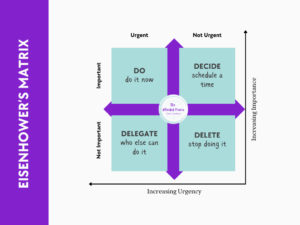Hey there, fellow chaos coordinators! Today, let’s dive into a game-changing strategy that can revolutionize the way you tackle your to-do lists and boost your productivity to new heights: the Eisenhower Matrix.
You might be wondering, “Who’s Eisenhower, and what does he have to do with time management?” Well, let me fill you in, because I didn’t know what it was either until I started doing research on different time management techniques. The Eisenhower Matrix, also known as the Urgent-Important Matrix, is named after Dwight D. Eisenhower, the 34th President of the United States and a master of prioritization. He once said, “What is important is seldom urgent, and what is urgent is seldom important.” This insight forms the basis of the matrix.
 Now, picture a simple four-quadrant grid. On one axis, you have tasks categorized as either “Urgent” or “Not Urgent,” and on the other axis, tasks are classified as “Important” or “Not Important.” By plotting your tasks into these quadrants, you gain a crystal-clear perspective on where to focus your time and energy.
Now, picture a simple four-quadrant grid. On one axis, you have tasks categorized as either “Urgent” or “Not Urgent,” and on the other axis, tasks are classified as “Important” or “Not Important.” By plotting your tasks into these quadrants, you gain a crystal-clear perspective on where to focus your time and energy.
This is especially helpful when you are sitting down to do your weekly plans, and even more so when you are evaluating things that come up during the week. You don’t have to have your plans derailed by unexpected additions – evaluate based on importance and urgency and make a decision based on where they fall on this matrix.
Let’s break down each quadrant:
1. Important and Urgent (Do):
These are the tasks that demand immediate attention. They are both important and time-sensitive. Think of deadlines, crises, or pressing issues. Instead of feeling overwhelmed, tackle these tasks head-on, prioritizing them based on their urgency and significance. This quadrant is your top priority zone. When these types of tasks drop into your week unexpectedly, as I had this past week, you may need to adjust your plans accordingly. Give yourself grace when things that were previously on your list have been pushed down on the priority scale…just keep doing the next right thing. When that roof starts leaking…you have to respond.
2. Important but Not Urgent (Decide):
Here lie the tasks that contribute to your long-term goals and aspirations. They may not be pressing at the moment, but they are crucial for your personal or professional growth. Examples include strategic planning, skill development, or relationship building. Allocate dedicated time in your schedule to tackle these tasks proactively, preventing them from becoming urgent down the line. For me, this means that I am ensuring that I am able to do my quiet time each morning before the house is awake; it settles my mind before starting the day. Even when dealing with an upheaval in my plans this past week, starting my day with my normal routine provided the stability that I needed to be able to push through and get things done.
3. Urgent but Not Important (Delegate):
Beware of this sneaky quadrant. These tasks scream for your attention, but they don’t necessarily align with your goals or priorities. Delegate whenever possible or consider if they can be deprioritized or eliminated altogether. Don’t let the illusion of urgency distract you from what truly matters. That last minute meeting someone dropped on your calendar…does it need to be done right now or can it be moved to a future time or can someone else attend in your place? Personally, I like to delegate the house-cleaning tasks to my kids. 🤣
4. Not Important and Not Urgent (Delete):
Ah, the land of distractions and time-wasters. These tasks offer little to no value and only serve to derail your focus. It’s time to Marie Kondo your to-do list and declutter this quadrant ruthlessly. Say goodbye to activities like mindless scrolling on social media or attending unnecessary meetings.
Now, let’s talk strategy. Here are some tips for effectively utilizing the Eisenhower Matrix:
– Regularly review and update your tasks: Priorities can shift, so it’s essential to reassess your to-do list periodically.
– Develop a habit of proactive planning: Anticipate and allocate time for important but not urgent tasks before they escalate.
– Practice assertiveness: Learn to say no to tasks that don’t align with your goals or responsibilities. No is a complete sentence.
– Embrace delegation: Don’t hesitate to enlist help when needed, whether from colleagues, family members, or outsourcing services.
Remember, the goal of the Eisenhower Matrix isn’t just to get more done—it’s to focus on what truly matters. By strategically allocating your time and attention, you’ll find yourself making significant strides towards your goals while maintaining a sense of balance and control in your life.
So, fellow planners, are you ready to conquer your to-do list like a boss? Let’s put the power of the Eisenhower Matrix into action and unleash our full potential. Your time is precious—spend it wisely. If you want to see this matrix in action – check out this video before you go!

Pingback: Get Stuff Done: How to Rock Your To-Do List with the ABCDE Method – The Blended Mama – Chaos Coordinator